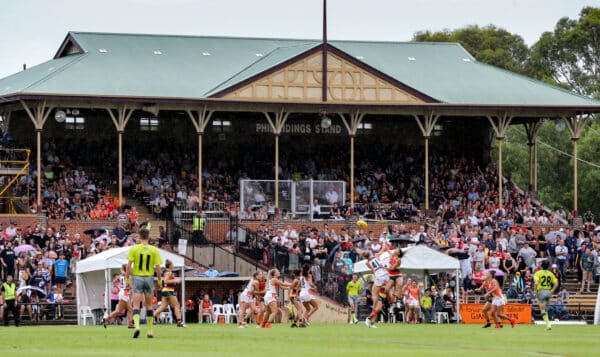Facilities timeline
Football Park, the stadium built at West Lakes by the SANFL in the early 1970s, was the Adelaide Football Club’s first home. Follow the timeline to find out how the Crows facilities developed over the next three decades.
For the first weeks of the new Club’s existence, general manager Bill Sanders, football manager Neil Kerley and other staff shared a small office under the SANFL members’ grandstand. The squad of players selected to train from late October used the regular SANFL changerooms and at first shared a gym with the SANFL umpires. There was only room for three or four players at a time. Training was occasionally on the main oval but the club also used the Max Basheer Reserve grounds on the eastern side of Football Park. In late November the first staff moved into a second-hand transportable building in the car park at the south-western end of the ground. Adelaide’s administration and football staff moved to a new brick building at the southern end of the stadium before the start of the 1992 season. It also housed the first small Crows shop.
Adelaide started the development of a new $2.3 million player and training facility on the eastern side of Football Park. The southern administration office was also extended. Initial SANFL approval for the training facility was given in 1993 but the SANFL’s planning for a second AFL licence, the SANFL clubs’ concerns about the potential impact on their distributions and an unsuccessful push to relocate the Adelaide Football Club to Norwood or Glenelg ovals stalled the build.
After five years of a nomadic existence for the football section, sharing rooms beneath the Football Park members’ stand, Adelaide shifted into its new changerooms and training facility. The clubrooms featured a players’ lockers area, 25m two-lane-pool, weights room, medical clinic, theatre meeting room, warm-up area, aerobic room, football staff offices, treatment areas, hydrotherapy spas and a clubroom for players and officials. It was described as “the best in the league”. Adelaide chairman Bob Hammond said: “The facility is an integral part in the development of a club ethos and soul that is a fundamental aspect of a successful club.” Players entered Football Park from a new race under the original scoreboard.
“Shed” parties for Crows members started later in the season in the old State Supply warehouse, east of Football Park, and proved popular as the Crows advanced to their first grand final and first AFL premiership.
A new two-storey administration block at the northern side of the Crows’ training facility opened at the end of 1998. It featured a new “Crowmania” store and also included a Crows Traveland outlet. The previous office building was sold to the SANFL.
Crows fans enjoyed the upgraded and bigger “Shed” before and after games. It used an old State Supply building at the eastern end of Max Basheer Reserve, next to the old Shed that had been used from 1997.
A second floor was added to the top of the administration building and used by the football department.
Adelaide confirmed plans to rebuild its training facility on the eastern side of AAMI Stadium. Planning and design took much of 2007. Major structural work started in November 2008 including the addition of 28 columns to support the other levels. Renovations to the inside of the existing facility were finished before the 2009 season, with the players using the visitor’s rooms on the western side of Football Park during the pre-season.
The $21 million upgraded training and entertainment facility, including a new 2500sq metre “Shed”, was officially opened in October 2009. The facility doubled in size with new weights, rehab and treatment areas, a range of function rooms, education zone, membership services centre, media centre, cafe and a museum, featuring a replica locker room. The new Shed proved its versatility, used by the players for training and pre-game warm-ups and by thousands of supporters after home games. The venue’s function rooms hosted more than 40 events each month ranging from weddings to funerals, birthdays and corporate events, and the new Schools in Crows program. Facility tours were popular.
Adelaide played its last AFL game at Football Park in 2013, leading to a re-evaluation of the facility’s use. The Crows remained based at West Lakes but game day functions areas were no longer required. Administration departments gradually moved from the old office into the newer building. An open space working area was created on the mezzanine floor, with views of the old Shed floor. The players’ gym moved to the western side of the Shed floor. The arrival of a Crows women’s team in 2016 led to further changes inside the facility to host the squad.
Adelaide’s AFL home games were moved to Adelaide Oval after the completion of a $575m redevelopment. Although the Crows continued to be based at West Lakes, the Club stopped having access to Max Basheer Reserve at end of the 2015 season after the land (owned by the SANFL) was sold to a developer. Adelaide’s AFLW side played its first game at Thebarton Oval in February 2017 and home games have since being played at suburban grounds including Norwood, Unley, Glenelg and Richmond. The side has also played some games, including three grand finals, at Adelaide Oval. Adelaide’s State League side joined the SANFL in 2014 and has played its games at every SANFL suburban ground, Adelaide Oval and some country venues.
The Adelaide Football Club identified Thebarton Oval as the best site to meet its long-term requirements for a new world class headquarters, training venue and home ground for its AFLW side.















































